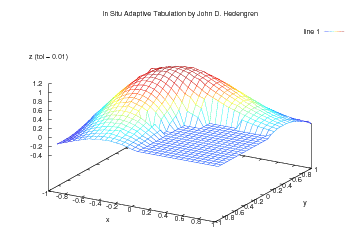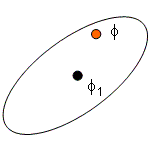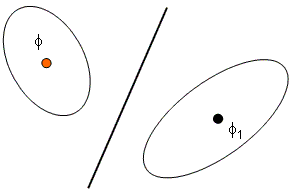In Situ Adaptive Tabulation (ISAT)
ISAT is a nonlinear empirical modeling approach that adaptively builds models as new information is requested. ISAT has been applied to simulations of turbulent reacting flows as well as nonlinear model predictive control (NMPC) to make real-time applications feasible. Like artificial neural networks, ISAT is a storage and retrieval method. Unlike neural nets, ISAT is adaptive to extrapolation. In addition, ISAT learns as it goes so there is no specified amount of training data before it starts performing.
- Nonlinear system: y=f(x), xєRn, yєRp
- ISAT approximation: y=A1x, y=A2x, y=A3x, etc.
- Additional information (PDF)
ISAT approximates nonlinear function of dependent variables, y, as a function of independent variables, x. This is accomplished by dynamically constructing local linear approximations that are stored in a lookup database.
Download Source Code
Animated Example
The animated graphic is an example with 2 independent variables (x and y as horizontal axes) and the 1 dependent variable (z as the vertical axis). ISAT approximates the function with multiple local linear regions. As the error tolerance increases, the approximation becomes increasingly granular to the point that individual linear regions can be observed.

The animation shows an ISAT approximation to the first eigenfunction of an L-shaped membrane. The error tolerance for z is steadily ramped from 0.01 to 0.99. The error tolerance of the current frame is indicated on the figure. Initially at a low error tolerance of 0.01, the approximation is nearly exact but requires 206 ISAT records. When the error tolerance is increased to 0.1, 48 ISAT records are stored. At an error tolerance of 0.5, only 12 ISAT records are required to meet the relaxed error bound. Explicit error control of the approximation of y is maintained by defining a region where the linear approximation is considered accurate. For n=1, this is a range on the value of x. For n=2, the estimate of the region of accuracy is an ellipse. For higher dimensional n, the estimate of the region of accuracy is a hyper-ellipsoid. For very nonlinear functions many linear approximations are required. For linear functions one record is required. ISAT takes a fundamentally different approach to nonlinear function approximation. Most other function approximation approaches attempt to fit the entire nonlinear surface with one functional form. By using multiple local approximations, the functional form adapts to the nonlinear function. With this free functional form, ISAT is ideally suited for nonlinear functions with discontinuities or non-continuously differentiable points.
Scenario 1: Retrieval

Scenario 2: Growth

Scenario 3: Addition

ISAT is suited to large-scale problems with O(n2+np) scaling, can approximate functions with discontinuities, explicitly limits approximation error, limits function approximation derivatives, and is adaptive to new data training without re-optimization.
References
- Pope, S. B., "Computationally Efficient Implementation of Combustion Chemistry Using In Situ Adaptive Tabulation", Combustion Theory Modelling, 1997, 1, pp. 41-63.
- Hedengren, J. D. and Edgar, T. F., Approximate Nonlinear Model Predictive Control with In Situ Adaptive Tabulation, Computers and Chemical Engineering, Volume 32, pp. 706-714, 2008. Article
- Hedengren, J. D. and Edgar, T. F., In Situ Adaptive Tabulation for Real-Time Control, Industrial & Engineering Chemistry Research, Ind. Eng. Chem. Res., Volume 44, Issue 8, pp. 2716 -2724, 2005. Article
- Hedengren, J. D. and Edgar, T. F., In Situ Adaptive Tabulation for Real-time Control, Proceedings of the American Control Conference (ACC), Boston, MA, pp. 2222-2227, July 2004.
Open-Source (MIT) License
Copyright (c) 2025 John D. Hedengren
Permission is hereby granted, free of charge, to any person obtaining a copy of this software and associated documentation files (the "Software"), to deal in the Software without restriction, including without limitation the rights to use, copy, modify, merge, publish, distribute, sublicense, and/or sell copies of the Software, and to permit persons to whom the Software is furnished to do so, subject to the following conditions:
The above copyright notice and this permission notice shall be included in all copies or substantial portions of the Software.
THE SOFTWARE IS PROVIDED "AS IS", WITHOUT WARRANTY OF ANY KIND, EXPRESS OR IMPLIED, INCLUDING BUT NOT LIMITED TO THE WARRANTIES OF MERCHANTABILITY, FITNESS FOR A PARTICULAR PURPOSE AND NONINFRINGEMENT. IN NO EVENT SHALL THE AUTHORS OR COPYRIGHT HOLDERS BE LIABLE FOR ANY CLAIM, DAMAGES OR OTHER LIABILITY, WHETHER IN AN ACTION OF CONTRACT, TORT OR OTHERWISE, ARISING FROM, OUT OF OR IN CONNECTION WITH THE SOFTWARE OR THE USE OR OTHER DEALINGS IN THE SOFTWARE.

